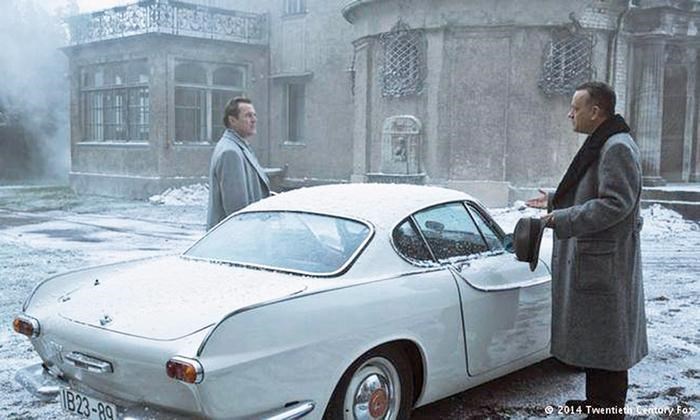The Oscar nominations are in, and amongst the usual controversy over the selections, there's the surprising choice of the Tom Hanks Cold War biopic Bridge of Spies.
Ridiculed by some as a spy movie without all those annoying tense parts, Spies is a relatively accurate look at the lowering of the Iron Curtain, the delicacy of negotiations between East and West at the height of mutuallyassured destruction, and Tom Hanks in a fedora again. Also, there are Volvos.
Specifically, there's a gorgeous white P1800, as owned by the character portraying East Germany's political negotiator. It speeds through the city, a ghostly spectre flickering through the desperation of ruined buildings, of families being divided by the raising of the Berlin Wall. It's something otherworldly, and to the casual observer, it makes no sense. Shouldn't this guy be ferried about in some colossal ZiL limousine, or driving a Trabant?
Well actually, no. The Volvo connection is one thing Spies gets absolutely right. In one of the odder twists of the Cold War story, everyone's favourite Swedish byword for safety became the must-have car for the ruling elite, a symbol of oppression, and a tantalizing luxury well out of reach of the average citizen. The Volvo symbol is, after all, the ancient shorthand for iron; little wonder that it pierced the Iron Curtain and became part of East Germany's story.
Whenever health-care, banking regulations, or education reforms are proposed, the tendency is to gaze longingly at the blond Scandinavian countries and wonder what makes them relative utopias. Is it the turtlenecks? The herring? The ABBA? Truth is, Scandinavian socialism has much the same problems as you find elsewhere.
Where Volvo is concerned, those problems were capitalistic in nature: namely, the ability to maintain a bottom line. A customer was a customer, and if those customers had a rather more extreme view of what socialism entailed, then so be it.
For the average East German, saving up for a car wasn't just about the money, it was also about getting in line. Hence, even the homely little Trabant had a waiting list as long as the arm of your ill-fitting hand-me-down coat. However, if you were part of the political ruling class, you couldn't be bothered with a smelly little duroplast car with a two-stroke turnip of an engine.
Nor did East German tastes really line up with Russian offerings. That ZiL limousine, for instance, came with a seven-litre V-8 engine, and was something of a tank at more than 3,000 kilograms of curb weight. The Russians were very good at tanks -extremely good, as the events of 1944-45 would show, but they weren't exactly dab hands at delicacy. Higher-ups in the Deutsche Demokratische Republik wanted to be seen driving something better than the average, but they also didn't want to be seen as total pawns of the USSR. A Mercedes was an impossibility, but a Volvo just might work.
A 1960s P1800 might have been a bit tricky, even for the head of the Stasi, but in later years getting a Volvo across the line wasn't totally difficult. The police force used a number of 240s, some of which now exist in museums. Regular Volvos ordered by the elite were passed on to favourites, doctors and lawyers and the like. That diagonally slashed grille became a mark of privilege and patronage.
But the oddest story is probably that of the limousines, based off of the Volvo 240, that were used as chauffeured cars by the ruling elite of Eastern Germany. These entered the country via Italy; Volvo had an agreement with design house Bertone to do a few restyled coupes, but there was also a winked-at trade of lengthened cars that made their way across the line into East Germany. These were custom made to specification, then fitted with false registration papers. While luxurious in length, any actual luxuries like air conditioning were optional extras, and many cars were delivered without them.
The actual cars delivered to the DDR were thus very weird indeed. Imagine, if you will, a 240 sedan lengthened out like a stretch Town Car and then fitted with a droptop landaulet rear. As a parade car for good weather, it made a statement.
And you can't get any stranger than a stretched-chassis Volvo 240 wagon, filled up with some Politburo member's luggage and headed to a private cottage on holiday.
If driving a Volvo wagon in the West meant that you were a progressive sort with an Irish setter and a cardigan, then the DDR equivalent came with a whiff of secret files and James Bond tied up in a cellar somewhere.
When the wall came down, the cars were mostly snapped up by West German collectors for what they represented. Once the economies of the two sides of Germany evened out, East Germans remained prejudiced against Volvos. They remain a very uncommon sight.
From time to time, the DDR Volvo limos appear at auction, or as part of an estate sale. They're an interesting footnote, a reminder of a time not so long ago that not everyone was faced with an enormous swathe of vehicles to choose from.
Once, those Swedish bricks we are all so fond of were just another brick in the wall.



